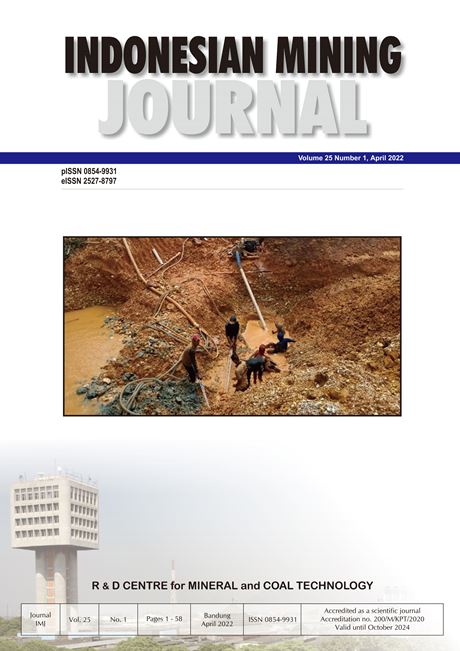Indexed by:
Vol. 25 No. 1 (2022): INDONESIAN MINING JOURNAL, Vol. 25 No. 1, April 2022

Slope stability analysis is a static or dynamic, analytical or empirical method to evaluate the stability of earth and rock-fill dams, embankments, excavated slopes, and natural slopes in soil and rock. Slope stability refers to the condition of inclined soil or rock slopes to withstand or undergo movement. When evaluating pit slope stability, we focus on high-quality rock mass characterization involving objective-driven geotechnical, structural geology, and hydrogeological investigation and data collection. Based on the operational and global study experience with all deposit types and commodities, a wide range of safety and economic factors should be considered when assessing stability and designing open pit slopes. By integrating all disciplines, we improve the implementation and functionality of these designs. A new concept to increase the safety and mining conservation on PT-X and PT-Y with no boundary gap between the two areas is presented in this paper. To optimize coal recovery as a basis of supporting conservation, the two companies needed to adjust coal production in terms of avoiding technical problems at the mining time process due to the rock structure and coal seam at the border was the same.
The prevailing mining climate is highly characterized by unstable consumables pricing systems, a volatile economy and skyrocketing operational costs as well as exacerbated by a steady decline and intermittence in the availability of electricity. Extensive capitalize on the opportunity to improve productivity is required by emphasizing variables they can control. Adopting the recommended short term production plans will avoid resizing of operations as stated in one of the papers in this issue. The papers discusses an overview on an open pit mine planning of the Pickstone Peerless in a volatile environment.
Indonesia’s earth is known for its rich gold deposits, drawing fortune seekers from across the country, especially poorer areas with few employment options. But while illegal gold mining – mining for gold without a permit – may be lucrative for some, for others it can be deadly. Illegal gold mining strips lands of its resources, destroying forests, water, and soil quality, leaving behind barren landscapes polluted by mercury. Illegal extraction of alluvial gold involves destructive processes that devastate the communities, the forests and the ecosystems. One of the papers in this issue discusses illegal mining activities at Jambi province, including history, socio-economic and environmental impacts, as well as recent technologies to reduce the environmental damage.
Upgrading the coal is a process that increases the calorific value of low-rank coal. The method usually applies mixed heavy oil to close the opened pores after coal upgrading. One study regarding increasing calorific value of the low-rank coal is included in this issue. The process was conducted by decreasing the moisture content of the coal. After the process, the lowest moisture content of the coal in the ratio of coal (b/v) and additives was 4:3 with 21.75% ad. The highest calorific value of the coal was shown in the ratio of coal (b/v) and additives 1:1 with 7,189 kcal/kg.
Fertilizer use efficiency has been the focus of agriculture cultivation practices to meet economic and environmental challenges. Unfortunately, available technology for improving such the efficiency is somewhat impotent as no significant breakthrough in fertilizer technology during the last several decades. It is possible to develop a new technology employing new paradigm in fertilization, i.e. improving soil capacity. Integration of microbes as consortium packages with the recent coating technology would be a promising approach to support sustainable agriculture. A paper regarding soil capacity improvement is presented in this issue.










